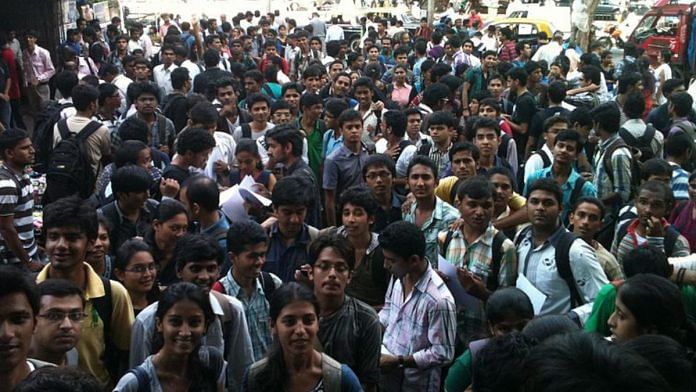New Delhi: India is estimated to cross China’s population in 2023, becoming the world’s most populous nation, according to the World Population Prospects by the United Nations Population Division. However, this is no achievement if employment opportunities continue to be a challenge, say experts.
Last week, researchers from US-based think tank Pew Research Center cited numbers from their recently published analysis on India’s population and demographics. ThePrint reached out to the authors of the analysis — Laura Silver, Christine Huang, and Laura Clancy — via Zoom to understand the implications of such a large population.
Responding to the questions posed by ThePrint, Huang, Pew Center’s research analyst on global attitudes, said that while India’s working-age population will form its majority at least till 2100, that comes with a pressure to create more employment opportunities.
“The UN estimates that India’s population will overtake China in April, and the majority of its population will remain of working age (ages 15 to 64) until at least 2100. The growing working-age population may pose a challenge to India’s labour market, and a lack of employment opportunities was already seen by Indians as the country’s biggest challenge in 2018,” she told ThePrint. “In comparison, there will be more Chinese people outside the working-age population than in it by 2079.”
Huang was citing a 2019 analysis authored by Kat Devlin, former research associate at the Center, which showed that an overwhelming 76 per cent surveyed respondents believed unemployment to be India’s biggest challenge.
Also Read: Why Australia’s Lowy Institute says India is Asia’s 4th biggest power but still an ‘underachiever’
Still got time
According to the Chinese government’s National Bureau of Statistics, the neighbouring country’s population shrank last year for the first time since 1960. China’s botched up population control measures further decelerated its population growth, and consequently, it is ageing faster.
“An ageing population may place additional strains on health care and other welfare systems and affect economic growth,” Huang said.
But she also added that the number of youngsters in India is so high that it would take approximately 26-27 more years to reach the present day median age of the US and China.
“India’s median age is markedly lower than that of the US or China. While the median ages of the US and China are already 38 and 39 respectively, India’s median age is not expected to reach 38 until 2050. The share of working-age adults in China is also projected to shrink more rapidly than in India,” she said.
However, according to the Ministry of Statistics and Program Implementation (MoSPI), India has already reached the point of inflection where its population has officially begun to age, but it would still take decades to see a visible impact.






